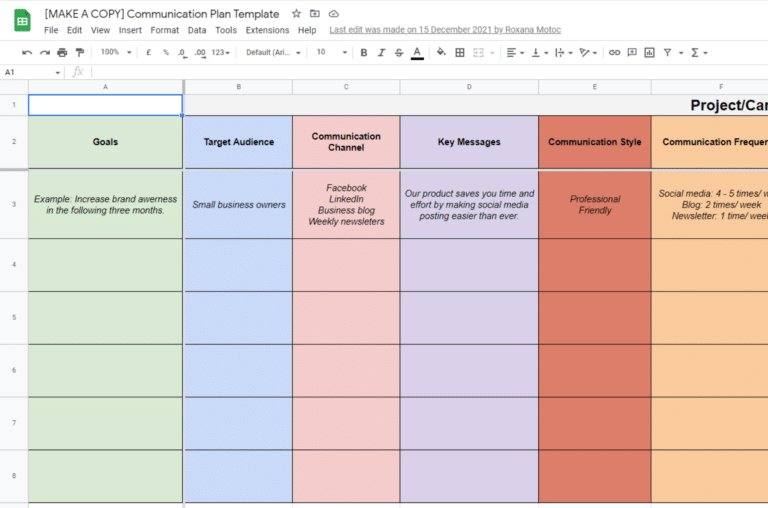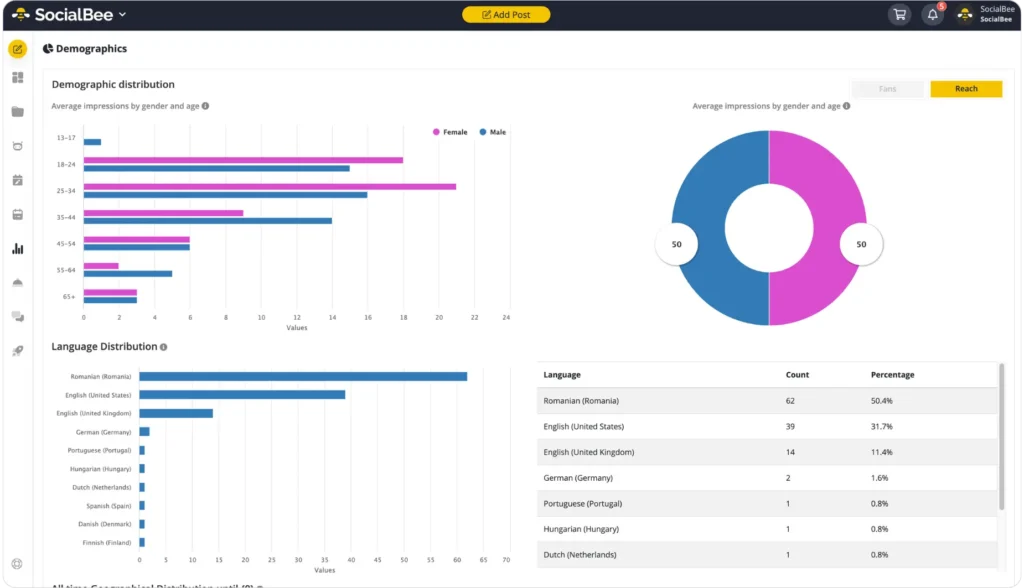
Content Manager at SocialBee
Omnichannel vs multichannel marketing? That is the question!
Research shows that 72% of consumers prefer to connect with businesses through multiple communication channels.
Nowadays, customers have a more complex buying journey. With multiple devices and communication channels at their disposal, they can research brands, compare prices and make sure they make the best purchase possible.
For this reason, businesses have to juggle several channels to make the most out of the customer experience and increase their profits. But the number of channels is not the only important aspect of a marketing strategy.
So, keep reading to learn about multichannel and omnichannel marketing, the pros and cons of each practice, and what you should choose for your business.

Omnichannel vs Multichannel Marketing
Before we move to understanding the key differences between omnichannel vs multichannel marketing, it is important to understand what each type of marketing stands for on its own.
First, let’s start by defining what is omnichannel marketing.
Omnichannel marketing is a holistic approach that uses multiple communication channels to help businesses interact with their customers. However, they are all integrated to offer the customer a personalized experience across all platforms.
Businesses that use an omnichannel marketing strategy prioritize the customer experience. That means that their communication changes based on the customer behavior. As a result, the transition from one channel to another is seamless and personalized for each person.
Examples of Omnichannel Marketing for Customers
- Getting promotional SMS messages while in a store
- Receiving emails after abandoning an online cart
- Seeing targeted ads about items viewed online
The purpose of multichannel marketing is to convince a prospect to act (buy a product, make an appointment, subscribe to their newsletter, etc.) by sharing the same message across all channels.
Multichannel marketing uses multiple online and offline channels like social media, email, direct mail, print, and more to help businesses communicate with their customers. However, they are not integrated, meaning that each channel has its own strategy and objectives.
Businesses that use multi-marketing channel are more focused on what they want to achieve at a certain point in time (sell more products, gain more newsletter subscribers) rather than considering the customer journey (maybe they already bought that product or subscribed to the newsletter). Using external tools can significantly change the results of omnichannel marketing, such as email marketing automation, SMS gateway API integration, social media writing assistants, etc.
Key Differences Between the Sales Channels
Although multichannel and omnichannel marketing has distinct strategies, most people may find it difficult to pinpoint what exactly makes them different. After all, they both have multiple similarities.
However, the details are the ones that make the difference.
Let’s look at the main characteristics that set apart multichannel marketing from omnichannel marketing:
- Main communication channels
- Company messaging and brand positioning
1. Main Communication Channels
With multichannel marketing, brands can increase their visibility by constantly sharing the same message on all their communication platforms.
The goal is to reach as many people as possible through all the channels available, from brochures and billboards to mobile communication and social media platforms.
Businesses that use multichannel marketing invest in communication platforms that raise awareness about the events, products, and services they promote. Some may also get a vanity number to take communication and customer support to the next level.
On the other hand, omnichannel marketing is more focused on creating a seamless experience for the customer. Meaning that businesses will use fewer communication channels, but they will be connected can be integrated into a single contact center for optimized interactions with customers. As a result, the customer will receive personalized messages based on their experience with the brand.
So in this case, the goal is not to increase brand visibility, but to cater to the specific needs of each customer and to provide a consistent customer experience.
In short, these are the main communication goals of the different marketing efforts:
- Multichannel Marketing: More brand visibility
- Omnichannel Marketing: Better customer experience
2. Company Messaging and Brand Positioning
Multichannel marketing uses communication channels to send messages from the company to the public.
Depending on how the audience reacts to their messages, businesses adjust their strategy in order to maximize their results — increase reach, customer engagement, boost sales, and more.
Omnichannel marketing has a different way of communication. Businesses first gather information about their customers and then send messages based on their research. In this way, they can adapt their promotional messages and increase the performance of their ads by providing the customers with the products and services they truly need.
So, in multichannel marketing, the center of the communication strategy is the company’s interests, while in omnichannel marketing, the priority is the customer’s needs and experience.
Let’s recap the differences in marketing channels strategies when it comes to company messaging:
- Multichannel marketing: Focuses on company goals
- Omnichannel marketing: Focuses on customer needs
Multichannel Marketing: The Pros and Cons
Now that you know what multichannel marketing is, it’s time to get a more detailed look by weighing the advantages and disadvantages that come with this marketing practice.
Let’s start on a positive note by talking about the pros of using multichannel marketing.
1. Multichannel Marketing: Pros
Using more than one channel of communication can make a key difference for your marketing offers, especially
Here are the benefits of multichannel marketing:
- More converting opportunities – Customers are not ready to purchase your products and services after being exposed to them just once. However, with multiple platforms at your disposal, you give them several opportunities to become paying customers of your business.
- Better audience reach – By using multiple communication channels, you can reach more potential customers. Not all the people from your target audience will use the same platforms. That is why it is so important to diversify the way you share your marketing messages.
- More brand awareness – Through a consistent presence across all communication channels, your brand will become more visible to your target audience. As a result, your potential customers will start recognizing your brand, products, and services.
- Fast results – Multichannel marketing focuses on promoting businesses on as many platforms as possible. And as a result, it reaches a significant amount of people in record time.
2. Multichannel Marketing: Cons
Before incorporating multichannel marketing into your strategy, you must consider the drawbacks that could affect your business.
Here are the main disadvantages of the multichannel approach:
- Complex management – With multiple individual channels, you will need to allocate more time and financial resources to create and implement marketing strategies for all the communication platforms.
- More quantity, less quality – Each communication channel has its characteristics and requirements. For your communication strategy to work, your team must be familiar with the specifics of each channel. By constantly increasing the number of communication platforms, the quality of your content will decrease due to the challenge of keeping up with the constant innovations of each platform.
- Lack of personalization – By not considering your customers’ purchasing history, your communication strategy will end up sounding impersonal. Moreover, it will frustrate your customers, and it will make them lose trust in your business.
- Unclear data – Because the communication channels are not integrated, the marketing data quality will suffer. More exactly, brands will have a hard time understanding:
- The audience and the customer journey
- What messages bring better results
Omnichannel Marketing: The Pros and Cons
To get a comprehensive understanding of omnichannel marketing, it’s best to research not only the pros but also the cons of such a practice. After all, you don’t want to invest in a marketing strategy that may not be suitable for your business model.
Let’s start with the advantages.
1. Omnichannel Marketing: Pros
Nowadays, people are used to always being exposed to marketing messages. As a consequence, it has become a challenge to capture their attention and maintain their trust.
To differentiate themselves, brands incorporate omnichannel marketing into their strategy. This level of care and customization helps businesses establish themselves as trustworthy and reliable entities.
Here are the main advantages of a successful omnichannel strategy:
- Quality customer experience – Through omnichannel marketing, you provide your consumer with positive and fulfilling customer experiences that give them a reason to keep purchasing from your business. Having a customer centric approach, you develop a loyal client base while increasing your customer retention rate.
- Positive word of mouth – Your customers are powerful brand ambassadors. Whether they recommend your products and services to friends and family or leave positive reviews, they will significantly improve your brand’s image.
- More sales – Omnichannel marketing encourages customers to make purchases. Through personalized messages, you can make your customers buy more by offering them products/services/promotions that suit their needs.
- Better customer understanding – Because omnichannel marketing relies so much on customer research, you will get to understand your target audience on a deeper level. Meaning that you will know their personality, buying behavior, pain points, wants, and needs. This information will help you adjust your products and services to make them a perfect fit for your customers, while also fostering your customer relationships.
2. Omnichannel Marketing: Cons
Omnichannel involves more than methods to engage customers, however. Now that you know the benefits, it’s time to look into the disadvantages you need to consider before incorporating omnichannel marketing into your business strategy.
The pain points of an omnichannel strategy are:
- Complex marketing strategy – Compared to multichannel marketing, omnichannel goes a few steps further. It’s not about separating your audience into specific segments of people. It’s about taking each individual client, following their interaction with your brand, and sharing with them messages customized to their needs. This requires more time and thinking than a multichannel strategy.
- Software investment – To run a successful omnichannel marketing strategy, you have to invest in new technology to integrate all the communication channels. In addition to the financial resources, you and your team will have to invest time and effort into learning how to use the software.
- Intense team collaboration – While putting the customer at the center of your business has multiple benefits, it also requires a lot of effort from your team. Moreover, many customer problems can only be solved through team collaboration. For example, let’s say you provide software for social media management. If a customer reaches out on social media asking for help with a platform issue, the social media specialist might need help from the engineering team to provide a solution.
What Is the Best Marketing Practice?
Multichannel and omnichannel marketing use multiple channel marketing, which makes them both effective promotional practices. To demonstrate, Omnisend conducted a study that revealed that businesses that use three or more communication channels have a 287% higher purchase rate than those that use single-channel marketing.
However, there are several reasons why one of them is better than the other. Although multichannel marketing has many benefits, omnichannel marketing goes a step further and provides businesses with outstanding results.
After all, your source of income is your customers. So any marketing practice that focuses on the customer experience will bring long-lasting and quality results. Research shows that 90% of customers expect consistent interactions across platforms.
Furthermore, omnichannel marketing can prevent issues that are common in multichannel practices, such as:
- Tone inconsistency between communication platforms
- Lack of integration between channels
- Impersonal customer experience
Besides providing your audience with multiple ways to engage with your brand, you also make the buying process an easier experience for them, as you have access to more customer data.
With SocialBee, you can get access to your customer’s analytics right from your dashboard.
For example, let’s say a customer adds an item to their cart but doesn’t make a purchase. Through the omnichannel integration, you can send an email reminder that will allow your customers to continue the purchase with just the link from the message. Thus, encouraging them to buy your product while saving them time.
While an omnichannel marketing strategy requires more work, it also improves customer retention. A study showed that businesses with a strong omnichannel strategy retain 89% of their customers, while companies with weak omnichannel marketing practices keep only 33% of them.
Omnichannel vs Multichannel: The Bottom Line
By using the information from this article, you can make your own decision regarding the best marketing practice for your business. Evaluate the pros and cons of each strategy, and choose the best option for your brand.
However, don’t forget that the customer experience has a significant impact on the success of your business.
With an omnichannel approach, you don’t only expand the channels you use to communicate with your customers, but you also create an effective system that benefits you and your clients.
No matter how you decide to communicate with your clients, rest assured: if you need to schedule any posts on social media, SocialBee is here for you. Start your 14-day trial now!













